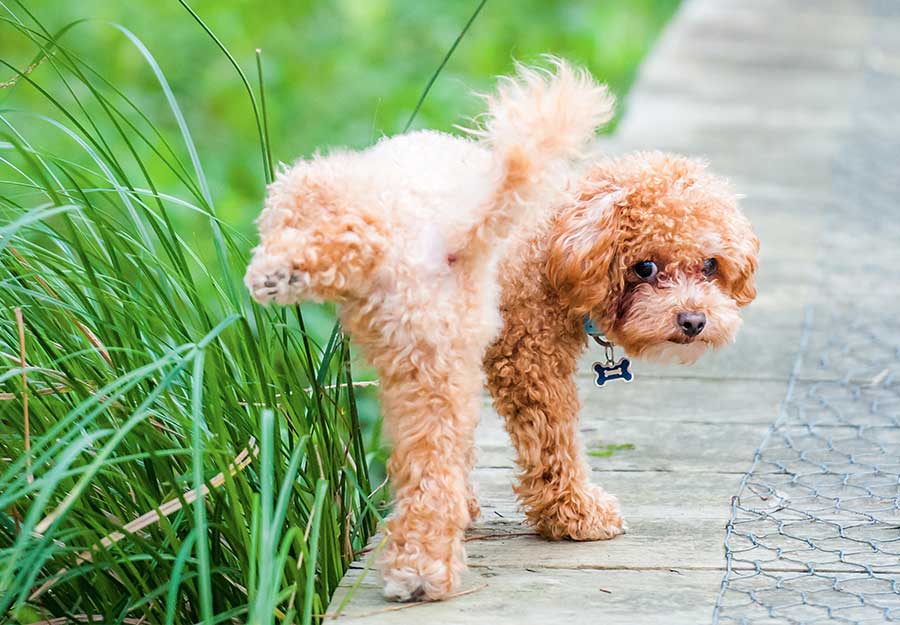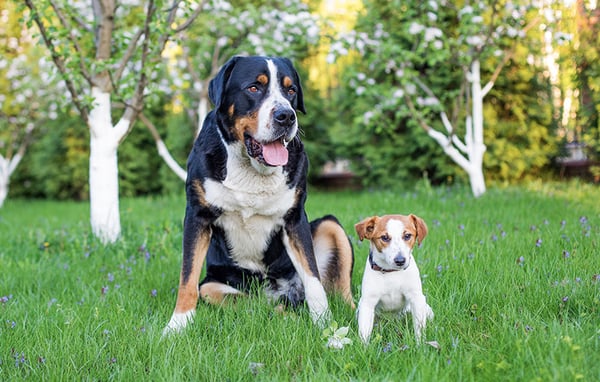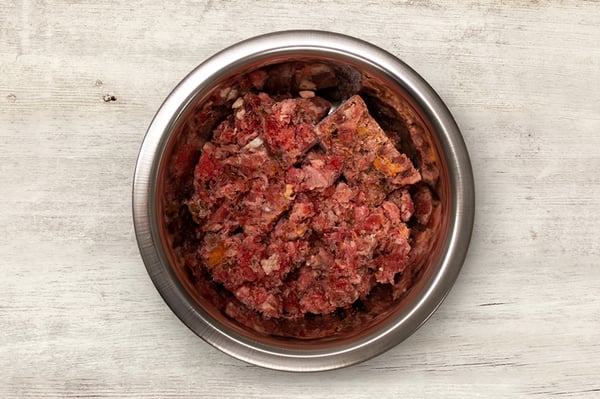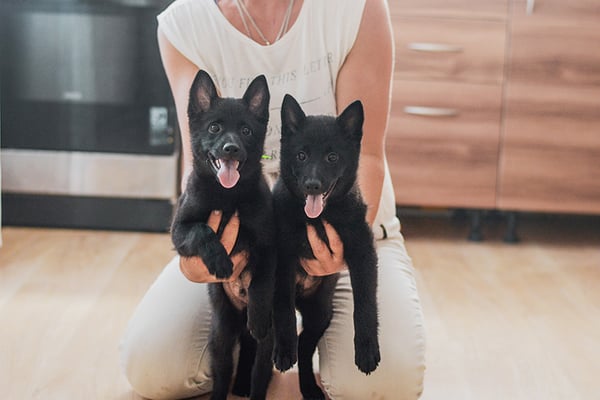
If you work long or inconsistent hours you may worry about how long you have to leave your dog home alone. How long can dogs hold their pee? Are you going to come home to an “accident”? Let's take a look at some of the factors that can help you make the best and safest choices for your pooch.
HOW LONG CAN DOGS HOLD THEIR PEE?
The topic of bathroom needs comes up often when we talk about the suitable amount of time that our pets can be left home alone. So, How long can a puppy hold his pee? Dogs are typically capable of holding their bladder for long periods of time, but it’s important to know how long is too long.
We don't always consider how long we are asking our dogs to hold it. If you frequently deal with "accidents" in the house, or even if you've never had a problem, this article will help you fully understand your dog's bathroom needs and help you make the best choices to support their urinary health.
How long dogs can hold their pee depends on a few factors:
Make sure that you understand your dog's bathroom needs, and create routines that prevent him from having to hold it for too long. Keep in mind:
AGE

Age is the most well-known variable in how long your dog can wait between bathroom breaks. Younger dogs, especially puppies who aren’t fully potty trained, won’t be able to hold their pee for as long as most adult dogs. This is, in part, due to their undersized and under-developed bladders and urinary tract systems.
It’s more than just holding capacity too. The muscle that contracts to hold and release thedog bladder take time to develop. Therefore, some puppies need bathroom breaks more frequently than others. Part of potty training is helping them build these muscles and learn how to control their bladder.
Senior dogs may start to lose that muscle control as they age, too. Weakening of the muscles, inflammation and mobility limitations, and even kidney and liver function can contribute to more frequent bathroom needs.
Here’s a quick chart to help you determine approximately how often your dog will need to pee in different age groups:
| Puppy (<6 months) = | 1-3 hours |
| Puppy (>6 months) = | 2-6 hours |
| Adult (<7 years) = | 6-8 hours |
| Senior (>7 years) = | 4-6 hours |
| Senior (>12 years) = | 2-4 hours |
These estimates are a good starting point but may not be accurate for every dog. Adult dogs can hold their pee for up to 10-12 hours if needed, but that doesn’t mean that they should. The average adult dog should be allowed to relieve itself at least 3-5 times per day. That's at least once every 8 hours.
SIZE

The size of your pet is also an important factor. A small or toy breed dog has a very tiny bladder compared to a larger dog. This doesn’t mean that all larger dogs have the capacity to hold their pee longer, but it could contribute to potty and house-training success. How long can a dog hold its pee?
It's estimated how often do dogs pee approximately 10-20 ml per pound of body weight. So a 5 lbs dog will pee between 1.7-3.5 oz per day. That's not a lot, but how much can their tiny bladders hold? Half an ounce? An ounce at best?
Every dog is different, and their bathroom habits are unique too. Our guidelines are general estimates, but your dog may fall well below or even exceed these averages. Make sure you are making a bathroom schedule that best suits your individual pup.
HEALTH
Many health conditions can contribute to more frequent urination. Urinary tract issues, kidney problems, diabetes, and even weight problems can be a factor.
Medications play a role as well. Some medications can have a diuretic effect, meaning it encourages more frequent urination.
If you have concerns that your pet is peeing more frequently than normal, it’s important to talk to your vet. It could be a symptom of a health issue that needs to be addressed.
DIET

The type of food you feed plays an important role in their urinary health. Moisture rich foods, like raw and wet food, can increase the amount and frequency of their pee. Hydration is good.
Even though your dog may need to pee a bit more often, moisture rich diets aid in digestion and can flush out toxins and bacteria that build up in their body. Dogs who eat a strictly dry diet, like kibble are may pee less, but that doesn’t mean they are healthier.
Just like in humans, the colour of their pee can indicate dehydration. Dark yellow pee is not a good sign. If you notice your dogs urine is very dark, then it’s time to up their moisture levels with water, broth, wet food, or even raw bones.
THE IMPORTANCE OF A BATHROOM ROUTINE
We mentioned earlier that adult dogs can hold their pee for quite a while. On average they can hold their pee for up to 10-12 hours is they have too. If the need arises and your pet will be home alone for that long, most adult dogs will manage, but asking them to do this on a regular basis may have some negative consequences.
Forcing your dog to hold his bladder for too long on a regular basis can increase the risk of:
- Urinary tract infections – part of the urination cycle is to help their body flush out bacteria and toxins that build up in the kidney, bladder, and urethra. Holding their pee allows that bacteria to continue populating in the urinary tract. This can lead to crystal or stone formation, and blockages that can quickly become life threatening. For dogs prone to urinary issues, try a urinary support product like Cranimals to help reduce bacteria build up.
- Urinary cancer – carcinogens in urine will have more opportunity to interact with cells the longer they are in contact with the bladder. This is a less common issues but should still be considered when deciding how long your pet must wait for a pee break.
- Incontinence – It's more common in ageing pets, but incontinence can happen to dogs at any age. When dogs are repeatedly made to hold their pee for too long, over-distention of the bladder can occur and damage the muscle and surrounding tissues leading to leaks. This damage may be irreversible, so prevention if key.
If your dog is experiencing any issues when it comes to bathroom needs, then you need to contact your vet immediately. Not peeing, straining to pee, peeing way too often, leaking, and blood in the urine are all signs of a much bigger issue.
POTTY TRAINING ISSUES
If you're dog is having accidents in the house consistently, then you may need to consider why. The first thing you should do it connect with your vet to rule out a medical issue. If your dog is healthy, then the problem could be behavioural.
EXCITEMENT PEEING

For puppies, and even young adults dogs, excitement peeing is common. This is commonly referred to as puppy piddles. When you walk in the door, does your dog immediately pee? It doesn't always mean that he just can't hold it any longer. It likely means that he is overwhelmed by the excitement of seeing you. How many times should a dog pee a day?
You can un-train this behaviour by simply ignoring your dog until he is calm enough to reward with attention. This will take time, patience, and consistency. Fortunately, many younger dogs out grow this habit on their own.
MARKING

Territory marking is another reason that your dog may be having accidents in the house. It's most common in un-neutered males, but fixed dogs of both genders can have this bad habit.
The psychology of territory marking is rooted in their natural instincts. It's a game of control. Often this habit forms when a new pet or person is introduced into the home that makes your dog feel that his position in the hierarchy is threatened.
Marking behaviours from intact dogs can usually be solved by getting them fixed. Talk to your vet about whether spaying or neutering your pet is the best option.
Fixed dogs that mark typically do so out of anxiety. Keeping your pet stimulated, both mentally and physically will relieve stress, anxiety, and fear. Anxiety relief products, such as the Thundershirt, can also be a helpful tool when managing marking behaviours. Check out the link below for more information on this great product.
Shop All Calming Aids for Dogs
BALANCING LIFE AND YOUR DOGS NEEDS
If your work schedule requires your dog to be home alone for 8+ hours per day, then there are options for looking after your dog’s urinary health. Choose the options that best suits your dog's needs.
- Pee pads – these are especially helpful for young puppies and dogs that are kennel trained.
- Indoor bathroom – For free roaming dogs, an indoor potty system can allow your dog to relieve themselves whenever they need to. Like a litter box for dogs. Which, by the way, also exists.
- Doggy door – If you have a secure, fenced backyard, consider installing a dog door. You dog can come and go as he pleases, and you can stop worrying about leaving him alone with no bathroom breaks.
- Dog sitter/Dog walker – Having a professional come in the middle of the day to check on and walk your dog is a great way to manage their bathroom schedule and prevent destructive behaviours from boredom.
- Doggy Daycare – If your dog needs constant attention or can’t be trusted at home alone, then doggy daycare is the way to go. This fun and engaging environment will allow him to run and play all day while being supervised by trained professionals.
- Lunch break check-up – This option is only great for those that live close to where they work. If you can, try to duck home on your lunch break for a quick hangout with your pooch. You can manage his bathroom needs, and give him some extra attention and exercise to break up his day.
- Bring your dog to work – of course, this isn’t feasible for most, but if you can, bring your dog to work with you. This is the best of both worlds for anyone lucky enough to have this option. Your dog doesn't have to be home alone, and you get to hang out with the coolest co-worker ever.
How long is your dog home alone? If you have any tips or struggles with managing your dog’s bathroom breaks let us know in the comments below.

